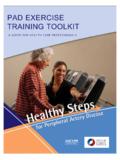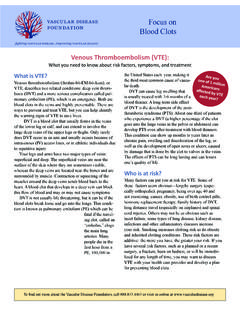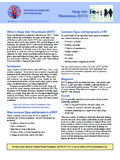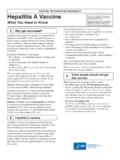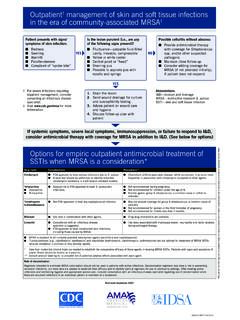Transcription of Focus on Varicose Veins - VascularCures
1 What are Varicose Veins ? Varicose Veins are the visible and large, bulging, surfaceveins, felt under the skin . They generally are larger than one eighth inch in width, and are usually located along the inside part of the calf or thigh. Varicose Veins develop due to weakness of the vein wall and because the valves of the Veins no longer work. Under the pressure of gravity these Veins can continue to expand and, in time, they may become longer, twisty, pouched, thickened and painful. Other Veins often mistaken for Varicose Veins are spider Veins and reticular Veins , which are the visible purple or greenish-blue Veins that appear in our legs. Spider Veins or teleangiectesias are tiny Veins that you can easily see, but cannot feel, and are usually located at the surface skin layers. Reticular Veins are larger than spider Veins but smaller than Varicose Veins and may cause symptoms. Spider Veins typ-ically do not cause symptoms, and treatment for these is frequently cosmetic unless symptoms are present.
2 Vein problems are among the most common chronic conditions in North America. In fact, more people lose work time from vein disorders than from artery disease. Varicose Veins affect up to 25 percent of women and 15 percent of men. By the age of 50, nearly 40 percent of women and 20 percent of men have significant leg vein problems. Spider Veins occurmuch more frequently in women. It is estimated that atleast 20 to 25 million Americans have Varicose Veins . Who is at risk?The most important factors leading to the developmentof Varicose Veins include: Family history of Varicose Veins Prolonged standing Increasing age Heavy lifting Prior blood clots in superficial or deep Veins Multiple pregnanciesLimited physical activity, high blood pressure and obesityhave also been linked with the presence of Varicose Veins in are the signs and symptoms? Varicose Veins may be entirely symptom-free and cause no immediate health problems. Treatment in such casesis usually considered cosmetic.
3 When symptoms arepresent, the most common are ankle and leg swelling, heaviness or fullness, aching, restlessness, fatigue, pain, cramps and itching. Varicose Veins can also be associated with ulcers (sores) of the legs. In the most severe cases, Varicose Veins may lead to thickening and discolorationof the skin of the legs, eczema and non-healing sores around the ankle area. Varicose Veins , especially whenthey are very large, are at risk of forming a blood clot,a condition known as superficial thrombophlebitis. If you experience any of these of Varicose Veins symptoms, talk with your doctor. Don t ignore leg pains. What are the causes?The causes of Varicose Veins are related to non-functioningvein valves. Vein valves are designed to allow blood to flow from the legs toward the heart against gravity, while preventing reverse flow back down the legs. Reverse flow is called venous reflux. Vein valves may fail to close dueo either, 1) vein wall weakness that causes the vein toenlarge and the valves to leak; 2) a history of blood clotsin the vein that damage the valves; or 3) an absence ofvein valves since birth.
4 Varicose Veins can be hereditary, often occurring in several members of the same family. Varicose Veins can also develop after trauma or injury. Regardless of cause, defective valves cause venousblood to stagnate (pool) in the legs, leading to highblood pressure in the leg Veins . This may result in further enlargement of the Varicose Veins , increasing the likeli-hood of advanced symptoms such as skin changes and ulcers at the ankles. Reflux in the largest superficial Veins , such as the saphenous Veins , is often an underlying cause of painful Varicose Veins . Venous reflux is a conditionthat can be progressive. If left untreated, it can worsenand cause more advanced symptoms. In addition, block-age of the Veins in the pelvis may severely aggravate the symptoms of Varicose Veins , requiring separate find out more about the Vascular Disease Foundation, call or visit us online at you need to know about risk factors,symptoms, and treatmentFocus onVaricose VeinsHow are Varicose Veins diagnosed?
5 The diagnosis of Varicose Veins is made primarily by physical examination. The accuracy of physical examina-tion is further improved with the aid of a hand-held Dop-pler (ultrasound) instrument, which allows the examiner to listen to the blood flow. The most accurate and detailed test is a duplex ultrasound exam, which provides an ultrasound image of the vein to detect any blockage caused by blood clots, and to determine whether the vein valves are work-ing properly or have evidence of reflux. Measurement of the venous function of the leg may also be obtained with other tests such as plethysmography. These diagnostic tests are non-invasive and are Varicose Veins treated? Varicose Veins are always a sign of an underlying venous insufficiency disorder, whether symptomatic or not. Tra-ditional treatments include making life-style modifications, wearing compression stockings and taking some medications. Patients with Varicose Veins are encouraged to lose weight, exercise and elevate their legs.
6 Compression stockings are effective in reducing swelling and pain. Low-dose diuretics (water pills) reduce swelling in the short term, topical steroid creams reduce inflammation, and antibiotics treat cellulitis ( skin infection). Horse chestnut seed extract is an herbal remedy taken to reduce short-term swelling, but this preparation has not been approved by the these traditional treatments are not successful, then endovascular procedures or surgery is recommended. Catheter-directed (endovascular) techniques have revo-lutionized the treatment of Varicose Veins , with reduced complications and time away from work. Vein stripping was the traditional treatment for bad values in the Veins however it is rarely used today due to the advancement of less invasive are the most common treatments: Prescription compression stockings to reduce the symptoms of Varicose Veins , prevent and reduce leg swelling and decrease the risk of blood clots. Prescription stockings offer appropriate counter- compression and are more effective than the over the counter stockings.
7 Sclerotherapy (injections of the Veins ) involves njecting a sclerosing solution into spider, reticular or Varicose Veins . This is a minimally invasive office procedure. This blocks the Veins that are unsightly or not working well. Injection of sclerosing solutions slowly eliminates the unsightly skin Veins to improve appearance. Patients typically receive multiple treat- ments and most see significant improvement over the course of several months of treatment. Ambulatory phlebectomy is also a minimally invasive procedure that can be performed under local, epidura or general anesthesia in an outpatient setting. Varicose Veins are removed with small hooks through tiny skin incisions. Stitchesare not used, and the tiny incisions are pulled together with sterile paper-tape. Re-covery is generally find out more about the Vascular Disease Foundation, call or visit us online at Laser treatments use a fine optical fiber, which is advanced through a catheter into the saphenous vein.
8 Laser energy is then delivered through the fiber. The fiber makes contact with the blood and inner wall of the vein and, as the fiber is slowly withdrawn, the laser energy is absorbed by the blood and vein tissue, sealing it shut. The procedure can be performed in the outpatient setting. Recovery time is usually fast with positive short and mid-term results. RF treatment involves controlled delivery of radio- frequency (RF) energy directly to a vein wall by a thin catheter causing collagen in the vein wall to shrink and the vein to close. Once the vein is closed, blood is naturally rerouted by the body to other healthy Veins . It has good results at two years with similar post-procedure pain, bruising, tenderness and recovery compared to other endovascular treatments. RF treatment is most commonly performed in a doctor s office or outpatient complications:Without treatment, Varicose Veins may cause pain oraching, leg swelling, skin color changes,hardened skinand subcutaneous tissue (lipodermatosclerosis),and eczema.
9 In advanced cases, breakdown of the skin may causebleed-ing from Varicose Veins , and large varicosities may devel-opblood clots, a condition called superficial phlebitis or thrombophlebitis. Patients with Varicose Veins may also eventually develop chronic skin ulceration around the ankle. 2012 VASCULAR DISEASE FOUNDATION 8206 Leesburg Pike, Suite 301 Vienna, VA 22182 31vdf2012 The Vascular Disease FounDaTionEstablished in 1998, The Vascular Disease Foundation (VDF) devel-ops educational information and initiatives for patients, their families and friends, and health care providers regarding often ignored, but serious vascular diseases. In fact, VDF is the only multidisciplinary national public 501(c)(3) non-profit organization focused on providing public education and improving awareness about vascular more information, visit the Vascular Disease Foundation continue to make this critical educational information available.
10 Your contribution will make saving lives a greater reality. Make a donation today at: you can do!You can t do anything about your heredity, age, or , you can help delay the development of Varicose Veins or keep them from progressing. Some things you can do: Be active. Moving leg muscles keeps the blood flowing. Work with your doctor to keep your blood pressure under control. To temporarily relieve symptoms, lie down and raise your legs at least six inches above the level of your heart. Do this for at least 10 minutes a few times each day. Strive for a normal weight. Wear your prescription compression stockings as specified by your doctor. See a qualified doctor who can diagnose the cause of your Varicose Veins , the sources of venous reflux in your legs, and offer a variety of treatment find out more about the Vascular Disease Foundation, call or visit us online at




